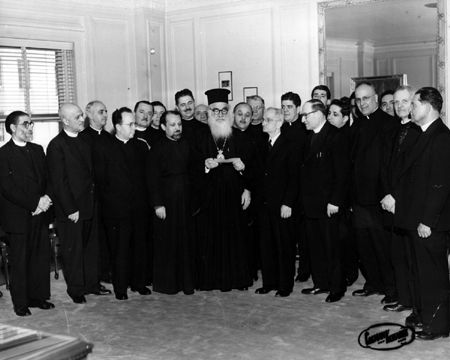The second modern era of our Church began with the arrival of Arch-bishop Michael on Dec. 15, 1949. For a decade, he had been the Metropolitan of Corinth and for 12 years prior he had been the dean of the Cathedral of St. Sophia in London.
Archbishop Michael’s personality was totally different from that of his predecessor, Archbishop Athenagoras. He was an intellectual, a deeply learned man, a theologian and an author. He was reserved in demeanor, a very quiet person and literally avoided publicity and personal popularity. He was a very pious, spiritual man concerned intensely with the sacramental life of the Church.
In succeeding a man of Archbishop Athenagoras’ stature and charismatic gifts, Archbishop Michael was faced with a great challenge. He made no effort to compete. He was not of a competitive nature and felt no need to win the acclaim of the populace.
As a result, his reign was particularly low key and totally different from the exciting and vibrant Athenagoras tenure.
It is reasonable to conclude that after 18 years of Archbishop Athenagoras, the time had come for a period of consolidating the unity that was gained with so many struggles.
Michael’s era was the 1950 decade of consolidating and extending the unity and reconciliation that Archbishop Athenagoras attained with so much blood, seat and tears during the 1930s and the 1940s.
Notwithstanding his lack of familiarity with the unique problems that confronted the administration and direction of our Church in the Americas, Archbishop Michael within a few months concluded that it was not possible to fund the Archdiocesan responsibilities with the “monodollarion.” As a result of the 10th Biennial Congress in November 1950 in St. Louis, Missouri, he recommended that the one dollar annual contribution to the Archdiocese is increased to $10 – the dekadollarion. To the surprise of many, there was practically no opposition either in committee or at plenary sessions.
By the time of his death eight years later, the annual income of the Archdiocese had increased from $100,320.25 during the last year of Archbishop Athenagoras’ monodollarion, to $585,698.99 under the dekadollarion for the 1958 calendar year.
Because boom times had come to the U.S. and the Greek American population had “matured” as citizens and economic units, Archbishop Michael, within his short reign, was able to increase the revenue of the Archdiocese six-fold.
Another significant contribution of Archbishop Michael was the organization in July 1951 of the Greek Orthodox Youth of America, popularly known as GOYA.
During his reign, GOYA mushroomed into nearly 250 communities in every part of the country. It was the first time that a serious centralized effort had been made to organize our young people under the aegis of our Church.
Archbishop Michael continued the efforts that were begun by Archbishop Athenagoras to obtain formal recognition of our church through resolutions adopted by the state legislatures directing that all references to major faiths, which were heretofore limited to Protestant, Catholic and Jewish, would hereinafter include the Greek Orthodox as well. As a result of this concerted action, 26 states adopted with uniform incorporation act or the major faith resolution.
The crowning event of this effort occurred in 1956 during the 13th Biennial Congress. President and Mrs. Eisenhower not only participated in the dedicatory ceremonies of the Cathedral of St. Sophia in the nation’s capital but joined us for nearly two hours in worshipping there. Then Vice President Nixon addressed one of its plenary sessions and Secretary of State John Foster Dulles was the principal speaker at the banquet.
There is no record of any other religious conclave in the history of the United States that had been so signally honored by the attendance at its functions of the three highest ranking officers of the nation: President, Vice President and Secretary of State.

Clergy present Archbishop Michael with first check for Clergy Benefit Fund
Peter Kourides for over 60 years, 1934-96, was the legal counsel to the Archdiocese. He is now retired and a member of Holy Trinity Archdiocesan Cathedral. This article is excerpted from his chapter “Our Three Hierarchs” published in “History of the Greek Orthodox Church in America”. (1984)